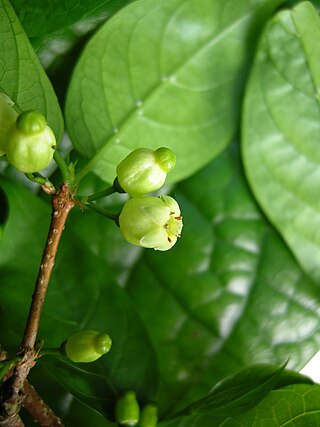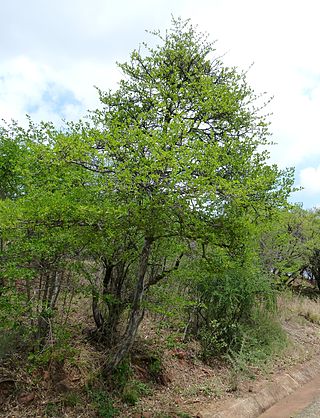
The Rubiaceae are a family of flowering plants, commonly known as the coffee, madder, or bedstraw family. It consists of terrestrial trees, shrubs, lianas, or herbs that are recognizable by simple, opposite leaves with interpetiolar stipules and sympetalous actinomorphic flowers. The family contains about 13,500 species in about 620 genera, which makes it the fourth-largest angiosperm family. Rubiaceae has a cosmopolitan distribution; however, the largest species diversity is concentrated in the tropics and subtropics. Economically important genera include Coffea, the source of coffee, Cinchona, the source of the antimalarial alkaloid quinine, ornamental cultivars, and historically some dye plants.

Canthium is a genus of flowering plants in the family Rubiaceae. They are shrubs and small trees. The leaves are deciduous and the stems are usually thorny.
Multidentia is a genus of flowering plants in the family Rubiaceae.

Psydrax is a genus of flowering plants in the family Rubiaceae. It consists of trees, shrubs, and a few lianas in the paleotropics.

Rytigynia is a genus of flowering plants in the family Rubiaceae. It is found in tropical and southern Africa. The genera Rytigynia and Fadogia form a strongly supported clade but neither of these genera is monophyletic.
Temnocalyx is a monotypic genus of flowering plants in the family Rubiaceae. It was originally described by Walter Robyns in 1928 and contained five species. Since then most of these species have been made synonym and currently only one species name remains valid, i.e. Temnocalyx nodulosa. The species is endemic to southwestern Tanzania.

Vangueria is a genus of flowering plants in the family Rubiaceae. The genus is named for Voa vanguer, as V. madagascariensis is known in Malagasy.

Vanguerieae is a tribe of flowering plants in the family Rubiaceae and contains about 655 species in 30 genera. It is one of the most species-rich groups within the family and it is distributed across the Paleotropics.

Fadogia is a genus of flowering plants in the family Rubiaceae. The genera Rytigynia and Fadogia form a strongly supported clade but neither of these genera is monophyletic.

Afrocanthium is a genus of flowering plants in the family Rubiaceae. It consists of deciduous, unarmed trees, and shrubs. They are native to East Africa, from Sudan and Ethiopia to South Africa.
Hutchinsonia is a genus of flowering plants in the family Rubiaceae. It was described by Walter Robyns in 1928 and was named after his friend and colleague John Hutchinson. It is found in west tropical Africa.
Eriosemopsis is a monotypic genus of flowering plants in the family Rubiaceae. It was described by Walter Robyns in 1928 and no changes have been made since then. The genus contains only one species, viz. Eriosemopsis subanisophylla, which is native to southeastern Eastern Cape and southern KwaZulu-Natal provinces of South Africa. The species is morphologically similar to the species Pygmaeothamnus zeyheri but differs by having a thick indumentum, raised venation and elliptical leaves.

Canthium armatum is a species of flowering plants in the family Rubiaceae. It is a shrub or tree native to southern Mozambique, Eswatini, and KwaZulu-Natal and the Northern Provinces of northeastern South Africa. The species is characterized by the presence of large spines.

Meyna is a genus of flowering plants in the family Rubiaceae.
Pygmaeothamnus is a monotypic genus of flowering plants in the family Rubiaceae. It was described by Walter Robyns in 1928 and originally held four species. It is found in central and southern Africa.
Fadogiella is a small genus of flowering plants in the family Rubiaceae. It was described by Walter Robyns in 1928.
Ancylanthos was a genus of flowering plants in the family Rubiaceae but is no longer recognized. It was originally described by René Louiche Desfontaines in 1818. In 2005, it was sunk into synonymy with Vangueria, based on a phylogenetic study of DNA sequences.
Vangueriella is a genus of flowering plants in the family Rubiaceae. The genus is found in tropical Africa.
Cuviera is a genus of flowering plants in the family Rubiaceae native to tropical Africa. It was originally described by Augustin Pyramus de Candolle in 1807 and is named after the French naturalist Georges Cuvier.
Globulostylis is a genus of flowering plants in the family Rubiaceae. It comprises 8 species growing in Central Africa.









